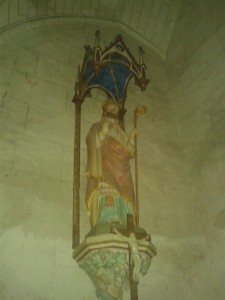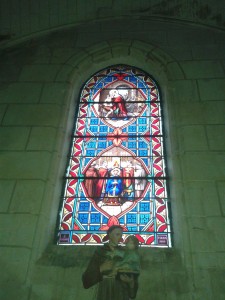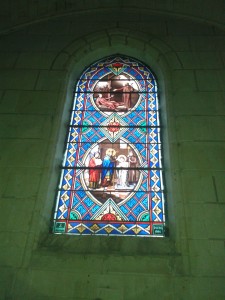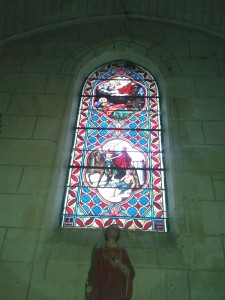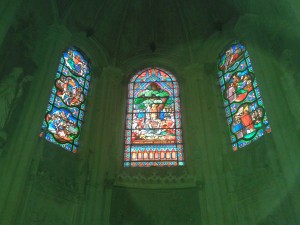Une première construction de l’église remonte à 1050. De l’église primitive, il ne reste plus que la façade occidentale avec une porte en plein cintre surmontée du même dessin aujourd’hui condamnée, une partie du clocher et la base de l’abside semi-circulaire. Le reste de l’église, dont le clocher a été emporté par un ouragan le 15 mars 1751 et la couverture a été refaite en 1777 après un incendie, fut complètement restauré de 1856 à 1863. Dans le chœur, un bas relief représente l’adoration des mages. Cette église dépendait du prieuré Saint-Cosme.
L’église abrite un important patrimoine martinien, une statue de saint Martin évêque, des vitraux représentant différents épisode de la vie de saint Martin, notamment une légende locale de saint Martin prêchant sous le châtaigner.
La statue est située à la droite du chœur. Saint Martin est représenté en évêque, mitré, tenant sa crosse dans la main gauche. Il porte une cape dorée et rouge, avec une dalmatique blanche et une aube bleue.
Trois vitraux présentant les événements de la vie de saint Martin sont situés dans la nef sud. Ils ont été réalisé par Julien Fournier et installés en 1886.
Le premier vitrail présente au registre supérieur la scène du songe de saint Martin où il voit le Christ, se trouve au dessus de la scène de la charité. Le songe de Saint Martin est très détaillé. Il est couché sur son lit où il dort. Saint Martin est nimbé, il est toujours vêtu de ses vêtements de soldat romain. Son manteau partagé lui sert de couverture. Au dessus de lui, entre des nuages, on peut voir le Christ, auréolé, qui tient dans ses mains l’autre partie du manteau. Le Christ est accompagné de deux anges. Derrière les trois personnages, on peut voir des rayons de lumière. Le registre inférieur présente une Charité de saint Martin. La scène se passe en hiver. Saint Martin, en cavalier romain nimbé, coupe son manteau avec son épée. Le pauvre est assis, un genou à terre. Il est a demi nu est porte un fardeau sur le dos. Il reçoit le manteau.
Le deuxième vitrail présente au registre supérieur la scène de la résurrection du catéchumène. Saint Martin, nimbé, se tient debout, dans une cellule où est couché un moine. Il tient un bâton, peut-être sa crosse d’évêque. Le moine se redresse et va pour prendre la main que saint Martin lui tend. En arrière plan, on peut voir que les moines entrent dans la cellule, ils applaudissent le prodige de saint Martin. Les couleurs sont sombres. Au registre inférieur présente le baptême de saint Martin. Martin est nu dans un drap, l’eau jusqu’au genou dans le baptistère, les main jointe, nimbé. L’évêque, mitré, nimbé, portant une chasuble bleue, sa crosse dans la main gauche, met la main sur la tête de Martin. Un moine porte un cierge derrière Martin alors qu’un autre, avec une chasuble rouge, tient un livre à côté de l’évêque.
Le troisième vitrail présente, au registre supérieur, saint Martin guérissant un lépreux à Paris. Saint Martin est en vêtement épiscopal liturgique, nimbé et mitré, portant une barbe blanche, avec une chasuble rouge. Il prend dans ses bras un lépreux, assis, à demi-nu, avec plusieurs bandes. En arrière plan, plusieurs personnes s’agitent. Au registre inférieur, on voit la consécration de saint Martin évêque. Martin est au centre de la scène, auréolé et assis sur un siège. Deux évêques sont autour de lui, ils lui placent la mitre sur la tête. Autour des évêques, des moines sont présents. Le vitrail est très coloré, il y a de nombreux détail du sacre.
Trois vitraux sont situés dans le chœur. Ils ont été réalisés par la Manufacture de vitraux du Carmel du Mans et sont installés en 1886.
Le vitrail central représente saint Martin évangélisant la population en l’an 388, et le passage du saint à Continvoir. Martin en évêque et auréolé se tient devant un arbre. Tout autour de lui, des gens prient ou sont à genoux devant lui. Il y a une inscription sur le vitrail : « saint Martin prêchant à Continvoir l’an 338 ».
Le vitrail de droite représente dans le registre supérieur le « rapt » du corps de saint Martin après sa mort et, dans le registre central et inférieur deux miracles de saint Martin.
Le vitrail de gauche représente, dans le registre supérieur, l’ascension de saint Martin, dans le registre central, la translation de ses reliques, et un miracle dans le registre inférieur.
The first construction of the church dates back to 1050. All that remains of the original church is the western façade with a round-headed doorway topped by the same design, which is now condemned, part of the bell tower and the base of the semicircular apse. The rest of the church, whose bell tower was swept away by a hurricane on 15 March 1751 and whose roof was redone in 1777 after a fire, was completely restored between 1856 and 1863. In the choir, a bas-relief represents the adoration of the Magi. This church was part of the priory of Saint Cosme.
The church houses an important Martinian heritage, a statue of Saint Martin the bishop, stained glass windows representing different episodes in the life of Saint Martin, notably a local legend of Saint Martin preaching under the chestnut tree.
The statue is located to the right of the choir. Saint Martin is depicted as a bishop, mitred, holding his crosier in his left hand. He wears a gold and red cape, with a white dalmatic and a blue alb.
Three stained glass windows depicting events in the life of St Martin are located in the south nave. They were made by Julien Fournier and installed in 1886.
The first window presents the scene of Saint Martin’s dream in the upper register where he sees Christ, above the scene of charity. The dream of Saint Martin is very detailed. He is lying on his bed where he is sleeping. Saint Martin is nimbed, still dressed in his Roman soldier’s clothes. His divided cloak serves as a blanket. Above him, between clouds, we can see Christ, haloed, holding the other part of the cloak in his hands. Christ is accompanied by two angels. Behind the three figures, rays of light can be seen. The lower register shows a Charity of Saint Martin. The scene takes place in winter. Saint Martin, as a nimbed Roman horseman, is cutting his cloak with his sword. The poor man is seated, one knee on the ground. He is half naked and has a burden on his back. He receives the cloak.
The second window in the upper register shows the scene of the catechumen’s resurrection. Saint Martin, wearing a nimbus, is standing in a cell where a monk is lying. He is holding a staff, perhaps his bishop’s crook. The monk stands up and goes to take the hand that Saint Martin is holding out to him. In the background, we can see that the monks are entering the cell, applauding the prodigy of Saint Martin. The colours are dark. In the lower register is the baptism of St Martin. Martin is naked in a sheet, water up to his knees in the baptistery, hands clasped, nimbed. The bishop, mitred, nimbed, wearing a blue chasuble, his crosier in his left hand, puts his hand on Martin’s head. A monk carries a candle behind Martin while another, wearing a red chasuble, holds a book next to the bishop.
The third stained glass window in the upper register shows Saint Martin healing a leper in Paris. Saint Martin is dressed in liturgical episcopal vestments, nimbed and mitred, wearing a white beard and a red chasuble. He is holding a leper in his arms, seated, half-naked, with several stripes. In the background, several people are stirring. In the lower register, we see the consecration of St. Martin as bishop. Martin is in the centre of the scene, haloed and seated on a chair. Two bishops are around him, placing the mitre on his head. Around the bishops, monks are present. The window is very colourful, with many details of the coronation.
Three stained glass windows are located in the choir. They were made by the Manufacture de vitraux du Carmel du Mans and installed in 1886.
The central window represents St Martin evangelising the population in the year 388, and the saint’s passage to Continvoir. Martin, as a bishop and haloed, stands before a tree. All around him, people are praying or kneeling before him. There is an inscription on the window: « Saint Martin preaching in Continvoir in the year 338 ».
The right-hand window shows the « abduction » of St Martin’s body after his death in the upper register and two miracles of St Martin in the middle and lower register.
The left-hand window shows the ascension of St Martin in the upper register, the transfer of his relics in the central register, and a miracle in the lower register.

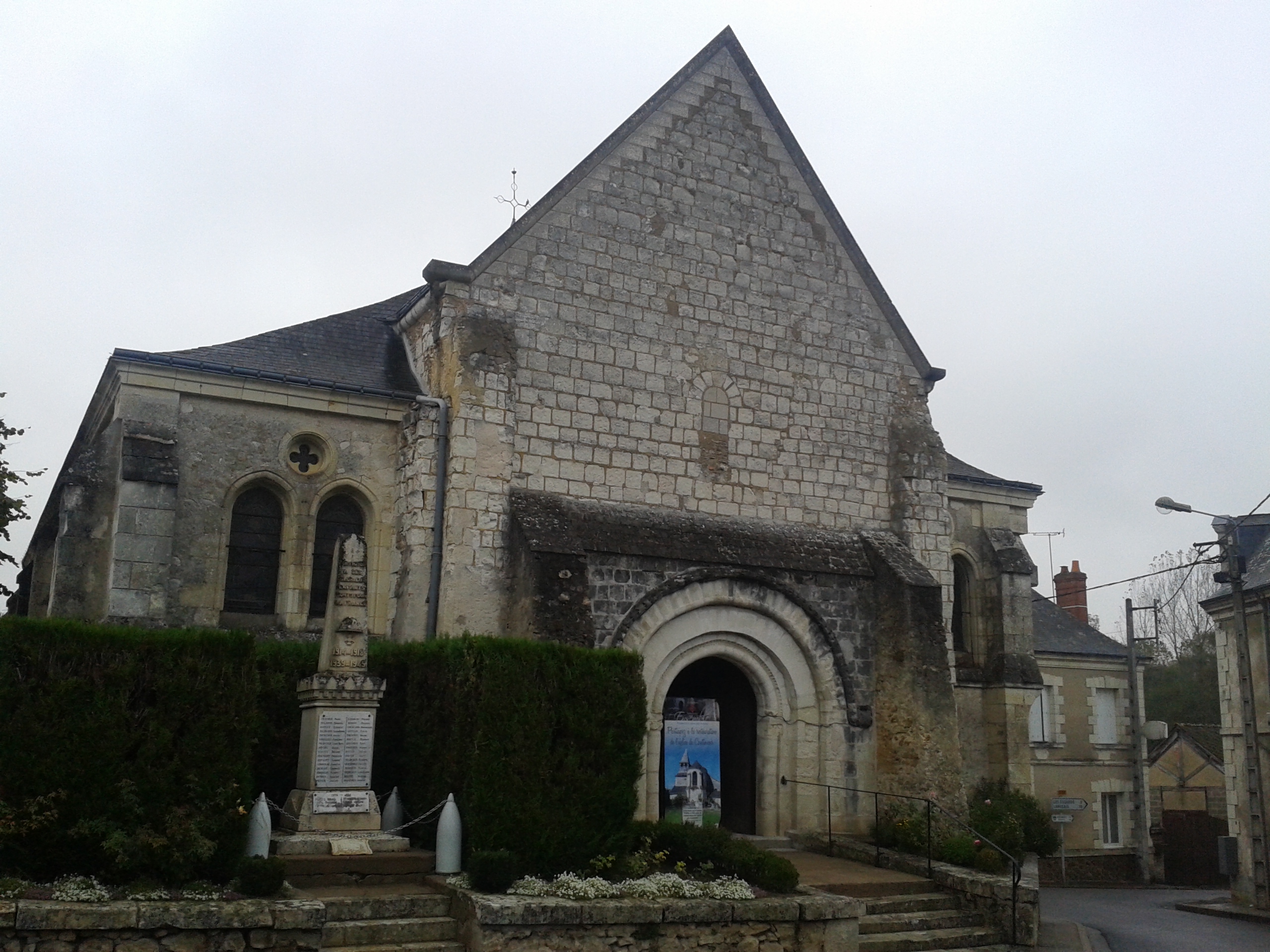 "/>
"/>
